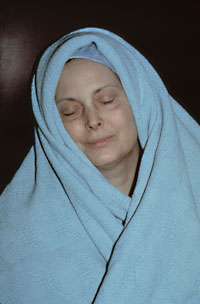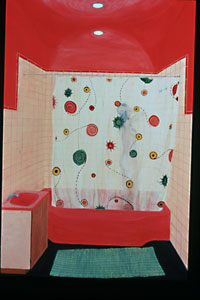Women’s bodies — nude, adorned, eroticized, abstracted — figure prominently in the history of art. Yet the art of women’s health is shockingly new.

The very concept of women’s health did not begin to take shape until the early 1970s, with the groundbreaking publication of Our Bodies, Ourselves, and “women’s health” did not appear as a subject in the Index Medicus, the massive, worldwide bibliographic listing of medical journal articles, until 1991.
In January, the Mildred Lane Kemper Art Museum at Washington University in St. Louis will present Inside Out Loud: Visualizing Women’s Health in Contemporary Art, the first major museum-level exhibition dedicated to the topic.
“Inside Out Loud traces the emergence of representations of women’s health in American art beginning around 1980, across the 1990s, and into the present in works by both male and female artists,” said guest curator Janine Mileaf, assistant professor of art history at Swarthmore College in Pennsylvania. “Rather than standing as an object of visual fascination, the female body in these artworks becomes a generating force that spurs artistic and conceptual innovations.”
Sabine Eckmann, Ph.D., curator of the Kemper Art Museum, added that, by highlighting the role of artists in the formation of the field of women’s health, “Inside Out Loud demonstrates that art and culture really matter. These kinds of visual representation make us conscious of issues that affect us daily.”
Inside Out Loud features approximately 50 artworks in a variety of traditional and cutting-edge media by more than 30 internationally known artists and artists’ groups.
These include Ida Applebroog, Sadie Benning, Maureen Connor, Mark Dion and J. Morgan Puett, Jeanne Dunning, Nan Goldin, Gran Fury, Lynn Hershman, Kathy High, Mamie Holst, Jenny Holzer, Nina Katchadourian, Barbara Kruger, Zoe Leonard, Kerry James Marshall, Sarah McEneaney, Orlan, Tony Oursler, Faith Ringgold, Martha Rosler, Donna Schumacher, Cindy Sherman, Katherine Sherwood, Kiki Smith, Ellen Spiro, Elisabeth Subrin, Tran, T. Kim-Trang and Hannah Wilke.
|
WHO: Mildred Lane Kemper Art Museum WHAT: Exhibition, Inside Out Loud: Visualizing Women’s Health in Contemporary Art WHEN: Jan. 21 to April 24; Opening 6 to 8 p.m. Friday, Jan. 21 WHERE: Mildred Lane Kemper Art Museum, Steinberg Hall, intersection of Forsyth and Skinker boulevards HOURS: 10 a.m. to 4:30 p.m. Tuesdays through Thursdays; 10 a.m. to 8 p.m. Fridays; noon to 4:30 p.m. weekends. Closed Mondays. COST: Free INFORMATION: (314) 935-4523 or kemperartmuseum@wustl.edu |
In addition, the show features one new work designed specifically for this show, the video installation Mood Swings, by Victoria Vesna.
The exhibition opens with a reception from 6 to 8 p.m. Jan. 21 and remains on view through April 24. Prior to the opening, Mileaf will host a panel discussion on “Art, Politics and the Body: A Conversation with Artists Zoe Leonard, Orlan, Katherine Sherwood, and Tran, T. Kim-Trang” from 4 to 6 p.m., followed by a performance of Women’s Bodies, Women’s Lives by That Uppity Theater Company from 6:15 to 7 p.m.
The Mildred Lane Kemper Art Museum is located in Steinberg Hall, near the intersection of Skinker and Forsyth boulevards. Regular hours are 10 a.m. to 4:30 p.m. Tuesdays through Thursdays; 10 a.m. to 8 p.m. Fridays; and noon to 4:30 p.m. weekends. (The museum is closed Mondays.) The exhibit is free and open to the public. For more information, call (314) 935-4523.
In conjunction with Inside Out Loud, more than 30 campus and community partners will present some 60 related events, ranging from lectures, concerts, exhibitions and theatrical performances to health seminars and screenings. To request a copy of Inside Out Loud: Guide to Community Events Exploring Women’s Health, call Stephanie Parrish at (314) 935-7918 or email stephanie_parrish@wustl.edu.
‘Art of Opposition’
“The Art of Opposition,” the first of three thematic sections, surveys the broad impact of women’s health activism as it intersected, in the early 1980s, with the dawn of the AIDS crisis and the rise of post-modernist theory.
Artists such as Nan Goldin, Faith Ringgold, Kiki Smith and Hannah Wilke directly engaged issues of illness, sexuality, addiction, AIDS and domestic violence, both in their own lives and in the lives of friends and families.
Meanwhile, postmodern feminists such as Barbara Kruger, Jenny Holzer and Cindy Sherman combined appropriated imagery with pithy text to confront media, cultural and governmental authority.

Wilke in particular emerges as a touchstone figure, shattering taboos that surround the depiction of women’s ailing bodies. In the photo diptych Portrait of the Artist with her Mother, Selma Butter (1978-1981), Wilke pairs a knowing, almost glamorous image of herself, chest dotted by small toy weapons, with a searing image of Butter, whose body has been ravaged by breast cancer, mastectomy and stroke.
A decade later, Wilke would chart her own struggles with lymphoma in works such as Intra-Venus #4 (1992), which documents the bloating and hair loss resulting from chemotherapy, while maintaining a playful attitude toward photographic self-portrayal.
Iconic of the period’s activism is Kissing Doesn’t Kill: Greed and Indifference Do (1989), by Gran Fury, the self-described propaganda wing of ACT UP (AIDS Coalition to Unleash Power). The piece, a bus advertising panel, featured the titular slogan along with three attractive, mixed-race couples of the same and mixed gender. Below them reads a second caption, “Corporate Greed, Government Inaction, and Public Indifference Make AIDS a Political Crisis.”
“The strategy of locating these images in the public domain rather than in a museum was essential,” Mileaf explained. “Unlike many of the artists in this exhibition, the members of Gran Fury placed the urgency of their message before artistic intentions. Their success as an artistic collaborative was an effect of their activism, rather than the reverse.”
‘Painting Public and Private’
The political climate grew less polemical in the 1990s, as women who had begun their careers as activists and protesters moved into positions of authority, but artists continued to explore the body in provocative and challenging ways.

“The resulting works are both more introspective and less accusatory than their forebears,” Mileaf noted, “but they are no less determined in their confrontation with the status quo.”
Painters such as Mamie Holst, Sarah McEneaney and Katherine Sherwood began to examine the private, personal experience of disease. Holst, who suffers from Chronic Fatigue and Immune Dysfunction, both attests to and transcends her physical limitations in the swirling, abstract spaces of the series Landscape before Dying, while McEneaney’s Self Examination (1992) and My Myomectomy (1994) document quiet moments from everyday life.
Sherwood — who suffered a cerebral hemorrhage in 1997, paralyzing the right side of her body — retrained herself to paint left-handed and began incorporating lattice-like forms derived from medical imaging technologies in abstract canvases.
Meanwhile, artists like Kerry James Marshall and Ida Applebroog focused on the patient’s loss of subjectivity. In Marshall’s Beauty Examined (1993), a woman’s body lies upon an examination table, vital statistics studding her form, the entire image superimposed over a pale field of medical textbook pages.
Similarly, the drab, monochrome figures of Applebroog’s 1956, from the series Living (1995-1996), reproach a host of social expectations: the clean home, the perfect marriage, physical and psychological stability.
‘Self-Reflected’
The 1990s also saw an explosion of new approaches to the body, many involving advanced media and technology, from photography and video to surgery, nanotechnology, genetic engineering and Web sites. “Self-Reflected,” the exhibition’s final section, surveys this territory as well as the ways artists have deployed their own bodies (and actors, friends and viewers) to question the meaning and validity of terms such as “healthy,” “normal,” “beautiful” and “sane.”
In a recent series of Hollywood-inspired photographs, Cindy Sherman, who first used herself as a model in the late 1970s, spoofs the cult of youth by donning the pancake make-up and too-tight clothing of fading starlets.
Sadie Benning — filming on a Fisher Price camera at the age of 17 — relates an eloquent tale of same-sex romance, while Vietnamese artist Tran, T. Kim-Trang chronicles the distressingly guileless responses of plastic surgeons asked to make her eyes appear more Western.
Perhaps most radically, the French performance artist Orlan actually does transform herself through a series of nine plastic surgeries, which she documented, narrated and televised.
Despite advances in women’s leadership, disorders associated with body image, self-esteem and social conformism have continued to flourish among adolescents and adults.
In Losing: A Conversation with the Parents (1977), Martha Rosler interviews a couple whose daughter died of anorexia, while Elizabeth Subrin’s video Swallow (1995) captures the sense of awe and even envy that inspires cultural manifestations of eating disorders and depression.
In contrast, the attractive, nonchalant young women photographed in Jeanne Dunning’s series The Blob (1999) seem to ignore or even embrace the amorphous, flesh-colored shapes threatening to overtake them.
Mileaf points out that, though there is little conformity amongst these artists’ methods, they share a conception of the “self” as unstable and varied — as a performed, rather than fixed, identity.
“From Hannah Wilke’s daring self-portrayals to Sadie Benning’s romantic retellings of the marriage scenario, the heterogeneity of artistic vocabularies used to address the subjects of women’s health coincides with the belief that the woman’s body has never signified a single, stable field,” Mileaf concludes.
“The art of women’s health builds upon these convictions to offer a field of visual innovation that challenges its audience to accept the mutability of health-related truths.”
Exhibition catalog
The full-color exhibition catalog, Inside Out Loud: Women’s Health in Contemporary Art, features a central essay by Mileaf, “The Subjects of Women’s Health,” and a forward by Mark S. Weil, Ph.D., the E. Desmond Lee Professor for Collaboration in the Arts and director of both the Kemper Art Museum and the Sam Fox Arts Center.
The volume also includes a 10-page timeline — organized by Barbara Baumgartner, associate director of the Women and Gender Studies Program in Arts & Sciences — of women’s health over the last 400 years; excerpts from Catherine Lord’s online diary “The Summer of Her Baldness: A Cancer Improvisation”; and the first English translation of a 1991 interview with artist and activist Zoe Leonard.
Inside Out Loud is published by the Mildred Lane Kemper Art Museum and designed by Heather Corcoran, assistant professor of visual communications and principal of Plum Studios. It retails for $25, and is available through the Kemper Art Museum, the Washington University Campus Store and area booksellers.
The Mildred Lane Kemper Art Museum
The Mildred Lane Kemper Art Museum (formerly the Washington University Gallery of Art) dates back to 1881 and the founding of Washington University’s St. Louis School and Museum of Fine Arts, making it the oldest art museum west of the Mississippi River.
Today, the Kemper Art Museum boasts one of the finest university collections in the United States, encompasses some 3,000 objects with the strongest holdings in 19th-, 20th- and 21st-century European and American art. Through its exhibitions and programs the Kemper Art Museum encourages discussion about the meaning of art and culture to contemporary life.
The Kemper Art Museum is committed to furthering critical thinking and visual literacy within the larger St. Louis community. It is one of five partners in Washington University’s planned Sam Fox Arts Center, an umbrella organization that also includes the School of Architecture, School of Art, Art & Architecture Library and Department of Art History & Archaeology in Arts & Sciences.
This fall, the Sam Fox Arts Center will begin construction of two new buildings designed by Pritzker Prize-winning Japanese architect Fumihiko Maki, including a 65,000-square-foot museum facility. Both buildings are scheduled for completion in 2006.